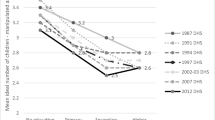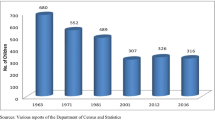Abstract
Studies on the family often assume that the normative expectations of having children are straightforward. However, in societies with sustained lowest-low fertility, each childbirth is seen as a thoroughly calculated decision. Using data from the Taiwan Youth Project (TYP), this study examines young adults’ reasons and sex preference for having children in Taiwan, where the total fertility rate is among the lowest in the world. We examine whether the values of children in Taiwan capture fertility desires and which ones do so, and how the importance of each value varies by birth parity. The findings show that young adults attach different values to the first, second, and third child. Additionally, while young adults in Taiwan do not consider economic utility as a primary value for having children, economic resources significantly shape their levels of desire to have children. Moreover, son preference has been largely replaced by the preference for a balanced sex composition. These results suggest that non-economic values, economic resources and sex preference intertwine to shape fertility desire in a context of lowest-low fertility. Implications for fertility policies within and beyond Taiwanese society are discussed.
Similar content being viewed by others
Notes
About 25% of the whole sample had one or more item nonresponse. Our estimation utilizes 25 imputed data sets to account for potential biased results from missing values.
References
Anderson, T., & Kohler, H.-P. (2013). Education fever and the east Asian fertility puzzle: A case study of low fertility in South Korea. Asian Population Studies, 9(2), 196–215.
Becker, G. S. (1960). An economic analysis of fertility. In Demographic and economic change in developed countries (pp. 209–240). New York: Columbia University Press.
Becker, G. S., & Lewis, H. G. (1973). On the interaction between the quantity and quality of children. Journal of Political Economy, 81(2, part 2), S279–S288.
Bollen, K. A., Glanville, J. L., & Stecklov, G. (2007). Socio-economic status, permanent income, and fertility: A latent-variable approach. Population Studies, 61(1), 15–34.
Bongaarts, J., & Potter, R. G. (1983). Fertility, biology, and behavior: An analysis of the proximate determinants. New York: Academic Press.
Brockmann, H. (2001). Girls preferred? Changing patterns of sex preferences in the two German states. European Sociological Review, 17(2), 189–202.
Brunson, J. (2010). Son preference in the context of fertility decline: Limits to new constructions of gender and kinship in Nepal. Studies in Family Planning, 41(2), 89–98.
Bulatao, R. A. (1982). The transition in the value of children and the fertility transition. In C. Hohn & R. Mackenson (Eds.), Determinants of fertility trends: Theories re-examined (pp. 95–112). Liège: Ordina Editions.
Chen, Y.-H., & Chen, H. (2014). Continuity and changes in the timing and formation of first marriage among postwar birth cohorts in Taiwan. Journal of Family Issues, 35(12), 1584–1604.
Choe, M. K., & Retherford, R. D. (2009). The contribution of education to South Korea’s fertility decline to “lowest-low” level. Asian Population Studies, 5(3), 267–288.
Chu, C. C., Tsay, R. S., & Yu, R. (2008). Intergenerational transmission of sex-specific differential treatments: The allocation of education resources among siblings. Social Science Research, 37(2), 386–399.
Chung, W., & Gupta, M. D. (2007). The decline of son preference in South Korea: The roles of development and public policy. Population and Development Review, 33(4), 757–783.
Clark, S. (2000). Son preference and sex composition of children: Evidence from India. Demography, 37(1), 95–108.
Cleland, J., & Wilson, C. (1987). Demand theories of the fertility transition: An iconoclastic view. Population Studies, 41(1), 5–30.
Doepke, M. (2005). Child mortality and fertility decline: Does the Barro-Becker model fit the facts? Journal of Population Economics, 18(2), 337–366.
Easterlin, R. A. (1975). An economic framework for fertility analysis. Studies in Family Planning, 6(3), 54–63.
Felson, M., & Solaún, M. (1975). The fertility-inhibiting effect of crowded apartment living in a tight housing market. American Journal of Sociology, 80(6), 1410–1427.
Freedman, D. S., & Thornton, A. (1982). Income and fertility: The elusive relationship. Demography, 19(1), 65–78.
Frejka, T. (2017). The fertility transition revisited: A cohort perspective. Comparative Population Studies, 42. Doi: https://doi.org/10.12765/CPoS-2017-09en.
Frejka, T., Jones, G. W., & Sardon, J.-P. (2010). East Asian childbearing patterns and policy developments. Population and Development Review, 36(3), 579–606.
Fuse, K. (2010). Variations in attitudinal gender preferences for children across 50 less-developed countries. Demographic Research, 23, 1031–1048.
Goldstein, J. R., Sobotka, T., & Jasilioniene, A. (2009). The end of “lowest-low” fertility? Population and Development Review, 35(4), 663–699.
Hank, K., & Kohler, H.-P. (2003). Sex preferences for children revisited: New evidence from Germany. Population, 58(1), 133–144.
Hannum, E., Kong, P., & Zhang, Y. (2009). Family sources of educational gender inequality in rural China: A critical assessment. International Journal of Educational Development, 29(5), 474–486.
Hoffman, L. W. (1975). The value of children to parents and the decrease in family size. Proceedings of the American Philosophical Society, 119(6), 430–438.
Hoffman, L. W., & Hoffman, M. L. (1973). The value of children to parents. In J. T. Fawcett (Ed.), Psychological perspective on population (pp. 19–76). New York: Basic Books.
Kohler, H.-P., Billari, F. C., & Ortega, J. A. (2002). The emergence of lowest-low fertility in Europe during the 1990s. Population and Development Review, 28(4), 641–680.
Lesthaeghe, R. (2010). The unfolding story of the second demographic transition. Population and Development Review, 36(2), 211–251.
Lin, T. (2009). The decline of son preference and rise of gender indifference in Taiwan since 1990. Demographic Research, 20, 377–402.
Lo, K. T. (2012). The crowding-out effect of homeownership on fertility. Journal of Family and Economic Issues, 33(1), 108–117.
Lovenheim, M. F., & Mumford, K. J. (2013). Do family wealth shocks affect fertility choices? Evidence from the housing market. Review of Economics and Statistics, 95(2), 464–475.
Mayer, B., & Trommsdorff, G. (2010). Adolescents’ value of children and their intentions to have children: A cross-cultural and multilevel analysis. Journal of Cross-Cultural Psychology, 41(5–6), 671–689.
McDonald, P. (2008). Explanations of low fertility in East Asia: A comparative perspective. In G. W. Jones, P. T. Straughan, & A. W. M. Chan (Eds.), Ultra-low fertility in Pacific Asia: Trends, causes and policy issues (pp. 41–57). New York: Routledge.
Ministry of the Interior, Republic of China. (2017). Department of Statistics [Tongji Chu]. https://www.moi.gov.tw/chi/chi_site/stat/news_detail.aspx?sn=13075.
Ministry of the Interior, Republic of China. (2019). Population Statistics [Renkou Tongji Ziliao]. https://www.ris.gov.tw/app/portal/346.
Myrskylä, M., Goldstein, J. R., & Cheng, Y. A. (2013). New cohort fertility forecasts for the developed world: Rises, falls, and reversals. Population and Development Review, 39(1), 31–56.
National Development Council. (2018). Population estimation of the republic of China, 2018–2065 [Zhonghuaminguo Renkou Tuigu, 2018 nian zhi 2065 nian]. Taipei: National Development Council.
National Statistics. (2004). Country population size and growth [Woguo Renkou Guimo yu Chengzhang]. https://www1.stat.gov.tw/ct.asp?xItem=15409&CtNode=4693&mp=3.
Nauck, B. (2007). Value of children and the framing of fertility: Results from a cross-cultural comparative survey in 10 societies. European Sociological Review, 23(5), 615–629.
Nauck, B. (2014). Value of children and the social production of welfare. Demographic Research, 30, 1793–1824.
Pollard, M. S., & Morgan, S. P. (2002). Emerging parental gender indifference? Sex composition of children and the third birth. American Sociological Review, 67(4), 600–613.
Rindfuss, R. R., St. John, C., & Bumpass, L. L. (1984). Education and the timing of motherhood: Disentangling causation. Journal of Marriage and Family, 46(4), 981–984.
Schoen, R., Astone, N. M., Kim, Y. J., Nathanson, C. A., & Fields, J. M. (1999). Do fertility intentions affect fertility behavior? Journal of Marriage and the Family, 61, 790–799.
Thornton, A., Binstock, G., Yount, K. M., Abbasi-Shavazi, M. J., Ghimire, D., & Xie, Y. (2012). International fertility change: New data and insights from the developmental idealism framework. Demography, 49(2), 677–698.
Toulemon, L., & Testa, M. R. (2005). Fertility intentions and actual fertility: A complex relationship. Population & Societies, 415, 1–4.
Trommsdorff, G., & Nauck, B. (2005). The value of children in cross cultural perspective: Case studies from eight societies. Lengerich: Pabst Science.
Van de Kaa, D. J. (1987). Europe’s second demographic transition. Population Bulletin, 42(1), 1–59.
World Population Review. 2019. Fertility rate by country 2019. http://worldpopulationreview.com/countries/total-fertility-rate.
Wu, T. (1977). The value of children: Taiwan. Honolulu: East-West Center.
Yi, C.-C. (2014). Continuity and change of intergenerational relations in family of Taiwan region: The interplay of resources and norms [Taiwan jiating daijian guanxi de chixu yu gaibian: Ziyuan yu guifan de jiaohu zuoyong]. Sociological Studies [Shehuixue Yanjiu], 170, 189–215.
Yi, C.-C., & Chen, Y.-H. (2014). The intergenerational transmission of the value of children in contemporary Chinese families: Taiwan and mainland China compared. Comparative Population Studies, 39(4). https://doi.org/10.12765/CPoS-2014-14en.
Acknowledgements
Data analyzed in this paper were collected by the research project “Taiwan Youth Project” sponsored by the Academia Sinica (AS-93-TP-C01). This research project was carried out by Institute of Sociology, Academia Sinica, and directed by Dr. Chin-Chun Yi. The Center for Survey Research of Academia Sinica is responsible for the data distribution. The authors appreciate the assistance in providing data by the institutes and individuals aforementioned. The views expressed herein are the authors’ own.
Author information
Authors and Affiliations
Corresponding author
Additional information
Publisher’s Note
Springer Nature remains neutral with regard to jurisdictional claims in published maps and institutional affiliations.
Rights and permissions
About this article
Cite this article
Hu, LC., Chiang, YL. Having Children in a Time of Lowest-Low Fertility: Value of Children, Sex Preference and Fertility Desire among Taiwanese Young Adults. Child Ind Res 14, 537–554 (2021). https://doi.org/10.1007/s12187-020-09753-5
Accepted:
Published:
Issue Date:
DOI: https://doi.org/10.1007/s12187-020-09753-5




